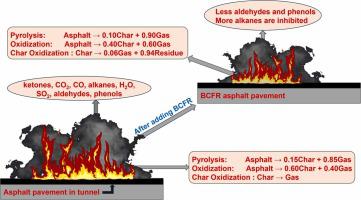当前位置:
X-MOL 学术
›
Constr. Build. Mater.
›
论文详情
Our official English website, www.x-mol.net, welcomes your feedback! (Note: you will need to create a separate account there.)
Flame retardance and fume inhibition of bio-based composite flame retardant on bituminous combustion and its numerical models
Construction and Building Materials ( IF 7.4 ) Pub Date : 2024-03-19 , DOI: 10.1016/j.conbuildmat.2024.135869 Ming Dong , Wenjing Xia , Tao Xu
Construction and Building Materials ( IF 7.4 ) Pub Date : 2024-03-19 , DOI: 10.1016/j.conbuildmat.2024.135869 Ming Dong , Wenjing Xia , Tao Xu

|
To investigate the effects of sustainable bio-based composite flame retardant (BCFR) on flame retardance and fume suppression of bitumen and establish unified combustion models of bitumen and BCFR bitumen, the mass loss and fume release during bituminous and BCFR bituminous combustion processes were studied using thermogravimetry-Fourier transform infrared spectroscopy (TG-FTIR) tests. Results show that when bitumen burns out, BCFR bitumen remains the residue rates of 33%, 28% and 21% at 5, 10 and 15 °C/min, respectively. BCFR dilutes active free radicals involved in combustion at early bituminous combustion stage, thus reducing the reaction rate, and then inhibits bituminous combustion by forming intumescent char layer, increasing the char yield of bitumen, strengthening the thermal stability of char produced from bituminous combustion. BCFR does not reduce the kinds of fume constituents released from bituminous combustion but inhibits the release of aldehydes and phenols mainly by suppressing the oxidation reaction at early bituminous combustion stage. BCFR can effectively suppress the fumes release amount during bituminous combustion at lower heating rates. The proportions of alkanes and ketones released at the second and third stages of BCFR bituminous combustion are larger than those of bituminous combustion by 9.27% and 5.8% at 15 °C/min, respectively. Although BCFR has limited inhibitory effects on fume release amount at a larger heating rate, it inhibits the volatilization and combustion of alkanes in bitumen. Meanwhile, the combustion models of bitumen and BCFR bitumen established can better reproduce TG test results. This study develops a cleaner and more efficient bio-based flame retardant, and provides a reliable bituminous combustion model for large-scale fire simulation.
中文翻译:

生物基复合阻燃剂对沥青燃烧的阻燃抑烟性能及其数值模型
为研究可持续生物基复合阻燃剂(BCFR)对沥青阻燃和抑烟的影响,建立沥青和BCFR沥青统一的燃烧模型,利用沥青和BCFR沥青燃烧过程中的质量损失和烟雾释放量进行研究。热重分析-傅里叶变换红外光谱(TG-FTIR)测试。结果表明,当沥青燃尽时,BCFR沥青在5、10和15℃/min时的残留率分别为33%、28%和21%。 BCFR在沥青燃烧初期稀释参与燃烧的活性自由基,从而降低反应速率,进而通过形成膨胀炭层来抑制沥青燃烧,提高沥青的成炭率,增强沥青燃烧产生的炭的热稳定性。 BCFR并不减少沥青燃烧释放的烟气成分种类,而是主要通过抑制沥青燃烧早期的氧化反应来抑制醛类和酚类的释放。 BCFR可以有效抑制沥青在较低加热速率下燃烧时的烟气释放量。 BCFR沥青燃烧第二阶段和第三阶段释放的烷烃和酮的比例分别比15℃/min时的沥青燃烧高9.27%和5.8%。虽然BCFR在较大加热速率下对发烟量的抑制作用有限,但它抑制了沥青中烷烃的挥发和燃烧。同时,建立的沥青和BCFR沥青的燃烧模型可以更好地再现TG测试结果。这项研究开发了一种更清洁、更高效的生物基阻燃剂,并为大规模火灾模拟提供了可靠的沥青燃烧模型。
更新日期:2024-03-19
中文翻译:

生物基复合阻燃剂对沥青燃烧的阻燃抑烟性能及其数值模型
为研究可持续生物基复合阻燃剂(BCFR)对沥青阻燃和抑烟的影响,建立沥青和BCFR沥青统一的燃烧模型,利用沥青和BCFR沥青燃烧过程中的质量损失和烟雾释放量进行研究。热重分析-傅里叶变换红外光谱(TG-FTIR)测试。结果表明,当沥青燃尽时,BCFR沥青在5、10和15℃/min时的残留率分别为33%、28%和21%。 BCFR在沥青燃烧初期稀释参与燃烧的活性自由基,从而降低反应速率,进而通过形成膨胀炭层来抑制沥青燃烧,提高沥青的成炭率,增强沥青燃烧产生的炭的热稳定性。 BCFR并不减少沥青燃烧释放的烟气成分种类,而是主要通过抑制沥青燃烧早期的氧化反应来抑制醛类和酚类的释放。 BCFR可以有效抑制沥青在较低加热速率下燃烧时的烟气释放量。 BCFR沥青燃烧第二阶段和第三阶段释放的烷烃和酮的比例分别比15℃/min时的沥青燃烧高9.27%和5.8%。虽然BCFR在较大加热速率下对发烟量的抑制作用有限,但它抑制了沥青中烷烃的挥发和燃烧。同时,建立的沥青和BCFR沥青的燃烧模型可以更好地再现TG测试结果。这项研究开发了一种更清洁、更高效的生物基阻燃剂,并为大规模火灾模拟提供了可靠的沥青燃烧模型。



























 京公网安备 11010802027423号
京公网安备 11010802027423号